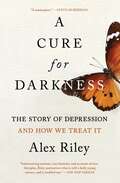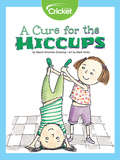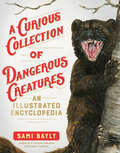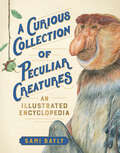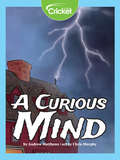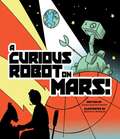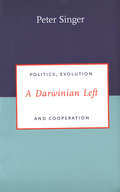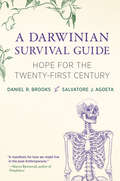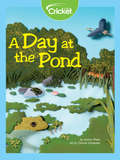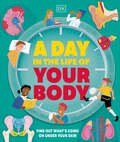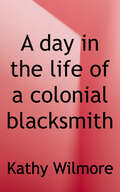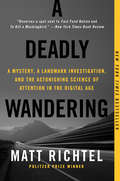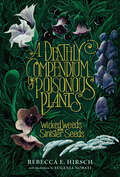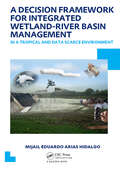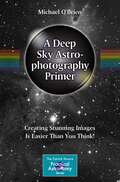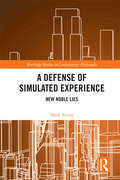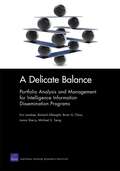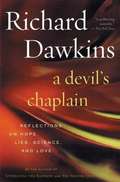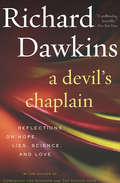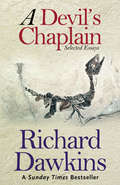- Table View
- List View
A Cure for Darkness: The Story of Depression and How We Treat It
by Alex RileyA fascinating look at the treatment of depression, blending journalism, science, history, and memoir, by an award-winning science writer.What is depression? Is it a persistent low mood or a complex range of symptoms? Is it a single diagnosis or a diversity of mental disorders requiring different treatments? In A Cure for Darkness, science writer Alex Riley explores these questions, digging into the long history of depression and chronicling the lives of psychiatrists and scientists who sought cures for their patients. Since 2015, Riley has received both cognitive behavioral therapy and antidepressants for his own depression. Throughout his treatment, he wondered—are antidepressants effective? Do short-term talking therapies actually work? And what treatments are on the horizon for those who don&’t respond to these first-line treatments? Expanding from his own experience, he tracks treatments through history, from the &“talking cure&” to electroconvulsive therapy to magic mushrooms. With depression fast becoming the leading burden of disease around the world, the future of mental healthcare depends not just on the development of new therapies, but on increasing access for people who are currently without. Reporting on the field of global mental health from its colonial past to the present day, Riley highlights a range of scalable therapies, including how a group of grandmothers stands on the frontline of a mental health revolution. Weaving in personal and family history, A Cure for Darkness is a gripping narrative journey and a surprisingly hopeful work that delves deep into the science of mental health.
A Cure for the Hiccups
by Naomi Kinsman DowningHave you ever had the hiccups? Amber and her sister want to find a cure! After multiple attempts, though, they still haven’t figured one out. Learn about why we get the hiccups and whether or not there’s a cure!
A Curious Collection of Dangerous Creatures: An Illustrated Encyclopedia (Curious Collection of Creatures #0)
by Sami BaylyFrom the frightening murder hornet to the fierce wolverine—a visual trove of the most dangerous animals on the planet, from the author of the beloved A Curious Collection of Peculiar Creatures Sharks, snakes, and spiders get all the attention, but many of the most terrifying animals on the planet are probably ones you didn’t know were so dangerous—like the otherworldly blue dragon, a tiny sea slug that can unleash a powerful sting, or the lethal mosaic crab, armed with a toxin 1,000 times deadlier than cyanide. And some creatures get rather creative when it comes to warding off predators—which is what makes them so amazing to read about. Take the adorable greater slow loris: This primate prepares to strike by first licking its venom-filled armpits! Before you run and hide, award-winning author and illustrator Sami Bayly shows how, once you understand why these animals have adapted to be so dangerous, you’ll learn to appreciate their scarier sides. They’re only trying to survive! And with so many of these species threatened or endangered, they’re counting on us to learn to love and protect them . . . from a safe distance! Publisher’s note: A Curious Collection of Dangerous Creatures was previously published in Australia under the title The Illustrated Encyclopaedia of Dangerous Animals.
A Curious Collection of Peculiar Creatures: An Illustrated Encyclopedia (Curious Collection of Creatures #0)
by Sami BaylyMake way for the world’s weirdest, most wonderful creatures—from the author of the forthcoming A Curious Collection of Dangerous Creatures Publisher’s Note: A Curious Collection of Peculiar Creatures was previously published in Australia as The Illustrated Encyclopaedia of Ugly Animals. What’s your favorite animal—a majestic lion, a graceful horse? Those are great choices, but have you considered the fangtooth moray eel? It has two rows of icicle-shaped teeth! And the monkey slug caterpillar is ready to cuddle . . . just look out for the stingers all over its body (and its six limbs that technically aren’t legs)! It’s true, these animals are a little different—but their unusual features often give them incredible superpowers. Take the nearly blind star-nosed mole: Its pink, flower-shaped nose can detect the microscopic texture of everything it touches, and it does this at warp speed—up to 12 objects per second! What’s more, many of these weird, wonderful creatures need our help: They’re endangered, and we can’t afford to ignore their well-being any longer. It’s time to find a peculiar creature to love! Why not the blobfish?
A Curious Collection of Wild Companions: An Illustrated Encyclopedia Of Inseparable Species (Curious Collection of Creatures #0)
by Sami BaylyHeartwarming, surprising, and downright bizarre creature connections Relationships can be complicated, and it’s no different in the wild. Meet 60 dynamic duos across the plant and animal kingdom—from “aww” to “eek”! The Eltham copper butterfly and the Notoncus ant are BFFs for life. The ants lovingly raise the butterflies’ caterpillar babies, while feasting on the sweet substance the caterpillars produce. Everybody wins in this prime example of mutualism. The pseudoscorpian is a total freeloader. When it wants to get around, it boards the back of the giant harlequin beetle, in a one-sided setup called commensalism. Parasitism is where things get spooky. Learn how the green-banded broodsac (a type of flatworm) first invades the eyestalk of the amber snail, then tricks it into getting eaten by a bird—inside which the broodsac will grow up. Yikes! Award-winning author and illustrator Sami Bayly shows us a whole world of wild companions like these—many endangered—and reminds us that we’re all inseparable.
A Curious Mind
by Andrew MatthewsBenjamin Franklin was often curious about the world around him. Utilizing observation and testing of the scientific method, he was able to invent many new items that improved the world for others. These inventions include his famous bifocal glasses, lightning rod, and even a long extension arm.
A Curious Robot on Mars!
by Bethany Straker James Duffett-SmithFar off into space--186 million miles to be precise--a fearless robot rover travels all by his lonesome. He is on a crucial mission from Earth, eagerly seeking to answer the much-anticipated question: Does life exist on Mars? But there is nothing to be seen on this planet except miles of rocks. He loses support from mission control and finds himself alone and cut off from civilization. But the curious little robot is resilient! After noticing a flash of light shining brilliantly through the crack of a rock, he instantly realizes his mission is far from over. He slowly inches towards the edge, but then suddenly falls perilously into the darkness! What will he discover?Bethany Straker's vibrant illustrations accompany James Duffett-Smith's suspenseful tale of discovery and hope. A Curious Robot on Mars! will motivate any and all readers to strive for one's ambitions--and most importantly, to always be curious!
A Cybernetic View of Biological Growth
by Tony StebbingMaia is the story of an idea, and its development into a working hypothesis, that provides a cybernetic interpretation of how growth is controlled. Growth at the lowest level is controlled by regulating the rate of growth. Access to the output of control mechanisms is provided by perturbing the growing organism, and then filtering out the consequences to growth rate. The output of the growth control mechanism is then accessible for interpretation and modelling. Perturbation experiments have been used to provide interpretations of hormesis, the neutralization of inhibitory load and acquired tolerance to toxic inhibition, and catch-up growth. The account begins with an introduction to cybernetics covering the regulation of growth and population increase in animals and man and describes this new approach to access the control of growth processes. This book is suitable for postgraduate students of biological cybernetics and researchers of biological growth, endocrinology, population ecology and toxicology.
A Dark Place in the Jungle
by Linda SpaldingFollow writer Linda Spalding to Borneo's threatened jungles on the trail of orangutan researcher Birute Galdikas, who together with Dian Fossey and Jane Goodall formed the famed trio of "angels" Louis Leakey encouraged to study great apes in the wild. She went into the jungle in 1971 and emerged decades later with a run-down empire crumbling around her. Spalding confronts the sad failure of a woman trying desperately to mother a species to survival; the dangers and temptations of eco-tourism; and the arrogance of our inclination to alter the things we set out to save.
A Darwinian Left
by Peter SingerIn this ground-breaking book, a renowned bioethicist argues that the political left must radically revise its outdated view of human nature. He shows how the insights of modern evolutionary theory, particularly on the evolution of cooperation, can help the left attain its social and political goals.Singer explains why the left originally rejected Darwinian thought and why these reasons are no longer viable. He discusses how twentieth-century thinking has transformed our understanding of Darwinian evolution, showing that it is compatible with cooperation as well as competition, and that the left can draw on this modern understanding to foster cooperation for socially desirable ends. A Darwinian left, says Singer, would still be on the side of the weak, poor, and oppressed, but it would have a better understanding of what social and economic changes would really work to benefit them. It would also work toward a higher moral status for nonhuman animals and a less anthropocentric view of our dominance over nature.
A Darwinian Survival Guide: Hope for the Twenty-First Century
by Daniel R. Brooks Salvatore J. AgostaHow humanity brought about the climate crisis by departing from its evolutionary trajectory 15,000 years ago—and how we can use evolutionary principles to save ourselves from the worst outcomes.Despite efforts to sustain civilization, humanity faces existential threats from overpopulation, globalized trade and travel, urbanization, and global climate change. In A Darwinian Survival Guide, Daniel Brooks and Salvatore Agosta offer a novel—and hopeful—perspective on how to meet these tremendous challenges by changing the discourse from sustainability to survival. Darwinian evolution, the world&’s only theory of survival, is the means by which the biosphere has persisted and renewed itself following past environmental perturbations, and it has never failed, they explain. Even in the aftermath of mass extinctions, enough survivors remain with the potential to produce a new diversified biosphere.Drawing on their expertise as field biologists, Brooks and Agosta trace the evolutionary path from the early days of humans through the Late Pleistocene and the beginning of the Anthropocene all the way to the Great Acceleration of technological humanity around 1950, demonstrating how our creative capacities have allowed humanity to survive. However, constant conflict without resolution has made the Anthropocene not only unsustainable, but unsurvivable. Guided by the four laws of biotics, the authors explain how humanity should interact with the rest of the biosphere and with each other in accordance with Darwinian principles. They reveal a middle ground between apocalypse and utopia, with two options: alter our behavior now at great expense and extend civilization or fail to act and rebuild in accordance with those same principles. If we take the latter, then our immediate goal ought to focus on preserving as many of humanity&’s positive achievements—from high technology to high art—as possible to shorten the time needed to rebuild.
A Data Engineering Approach to Wave Scattering Analysis with Applications in Radar, Sonar, Medical Diagnostics, Structural Flaw Detection and Intelligent Robotics
by Mark K. HindersComprehensive resource exploring how recent advancements in computational capabilities open doors to new applications in wave scattering A Data Engineering Approach to Wave Scattering Analysis: with Applications in Radar, Sonar, Medical Diagnostics, Structural Flaw Detection and Intelligent Robotics applies scattering analysis to many applications including radar, sonar, medical diagnosis, intelligent robotics, and more, enabling readers to implement new and better measurements with both novel instrumentation and artificial intelligence that automates the interpretation of various (and multiple) imaging data streams. Composed of 10 chapters, this book brings together separate scientific topics that share a common basis of knowledge and their unchanged mathematical techniques to ensure successful results. Through periodic exercises, this book reinforces the importance of revisiting derivations and reproducing established results. It also delves into the individuals who shaped scientific methods and technologies, exploring 81 notable names and providing insights into their professional journeys. Classic results from scattering are included in each chapter, and rather than simply pasting in plots from classic papers, these results have largely been reproduced for a more coherent reader experience. Written by an established academic in the field, A Data Engineering Approach to Wave Scattering Analysis: with Applications in Radar, Sonar, Medical Diagnostics, Structural Flaw Detection and Intelligent Robotics includes information on various topics: Field equations, covering strain as a dimensionless measure of deformation, generalized Hooke’s Law, and elastic and acoustic wavesReflection and refraction, covering reflection from a free surface and surface waves as well as the wave model of acoustic microscopyGuided waves, covering torsional modes, longitudinal waves, and flexural waves in rods, as well as data engineering for lamb wave tomographyInverse scattering, covering wavelet transforms and fingerprinting as well as applications of wavelet fingerprints such as roof fall detection A Data Engineering Approach to Wave Scattering Analysis: with Applications in Radar, Sonar, Medical Diagnostics, Structural Flaw Detection and Intelligent Robotics is an essential up-to-date reference on the subject for researchers interested in radar, sonar, medical imaging, structural health monitoring, manufacturing process control, and autonomous vehicles, as well as upper-level undergraduates and graduate students in related programs of study.
A Day at the Pond
by Jestine WareLearn about the plant and animal life a pond supports. Duckweed, beetles, birds, and turtles call enjoy the environment of a pond.
A Day in the Life of Your Body: Find Out What's Going on Under Your Skin
by DKTake a behind-the-scenes look at everything the human body is up to throughout the day in this science book for kids.Ever wondered what happens inside your body from the moment you wake up until you fall asleep? Follow children from around the world through their daily lives, uncovering the amazing secrets of the human body along the way.A Day in the Life of Your Body dives into the fascinating world of all the organs and systems that keep us going, from the adrenaline rush of a morning run to the brainpower behind solving math problems. Children aged 9-12 will be amazed by the extraordinary things your body does every single day!This human body book for curious children offers: Explanations of core human body content through the daily activities of children from around the world–from getting ready for school to falling asleep at night.Psychology content that explains common emotions kids might feel during the day, such as fear and anxiety.Bright and eye-catching visuals that helps explain complex concepts to children in an easy-to-understand way.Why do we get goosebumps? What causes us to fart? Discover the answers to these questions and more with fun facts, colorful illustrations, and engaging explanations. Perfect for budding scientists, this book transforms everyday activities into a thrilling scientific adventure.
A Day in the Life of a Colonial Blacksmith (The Library of Living and Working in Colonial Times)
by Kathy WilmoreDescribes the life of a blacksmith in Colonial Maryland, including his daily work, some of the many things he made, and his importance to the town in which he worked.
A Day with a Doctor (Hard Work)
by Jan KottkeStudents will learn about the exciting aspects of a given job from the point of view of a professional in the field. Original, dynamic photographs illustrate text exactly to ensure young readers' comprehension.
A Deadly Wandering
by Matt RichtelA landmark exploration of the vast and expanding impact of technology, rivetingly told through the lens of a deadly collisionOne of the year's most original and masterfully reported books, A Deadly Wandering by Pulitzer Prize-winning New York Times journalist Matt Richtel interweaves the cutting-edge science of attention with the tensely plotted story of a mysterious car accident and its aftermath to answer some of the defining questions of our time: What is technology doing to us? Can our minds keep up with the pace of change? How can we find balance? Through Richtel's beautifully constructed narrative, a complex and far-reaching topic becomes intimate and urgent--an important call to reexamine our own lives.On the last day of summer, an ordinary Utah college student named Reggie Shaw fatally struck two rocket scientists while texting and driving along a majestic stretch of highway bordering the Rocky Mountains. Richtel follows Reggie from the moment of the tragedy, through the police investigation, the state's groundbreaking prosecution (at the time there was little precedent to guide the court), and ultimately, Reggie's wrenching admission of responsibility. Richtel parallels Reggie's journey with leading-edge scientific findings regarding human attention and the impact of technology on our brains--showing how these devices, now thoroughly embedded into all aspects of our lives, play to our deepest social instincts and prey on parts of the brain that crave stimulation, creating loops of compulsion, even addiction. Remarkably, today Reggie is a leading advocate who has helped spark a national effort targeting distracted driving, and the arc of his story provides a window through which Richtel pursues actionable solutions to help manage this crisis individually and as a society. A propulsive read filled with fascinating scientific detail, riveting narrative tension, and rare emotional depth, A Deadly Wandering is a book that can change--and save--lives.
A Deathly Compendium of Poisonous Plants: Wicked Weeds and Sinister Seeds
by Rebecca E. Hirsch"Should you encounter any of the plants in this book, do not treat them lightly. They can kill you. Or cause you unbearable agony. Or land you in jail. Consider yourself warned." Explore the strange and remarkable stories of poisonous and even deadly plants. Science, history, and true crime converge in an informative and exciting look at Mother’s Nature’s ghoulish garden. From a hallucinogenic fungus linked to the Salem Witch Trials to the weed that killed Abraham Lincoln’s mother, learn how certain plants evolved toxicity to avoid being consumed by predators and became the predator on their own. In A Deathly Compendium of Poisonous Plants: Wicked Weeds and Sinister Seeds author Rebecca Hirsch takes you on a wild journey to look at how toxic chemicals in the natural world have been used for medicine, warfare, and sinister acts of foul play. Tread lightly as we explore these plants’ ominous deeds.
A Decision Framework for Integrated Wetland-River Basin Management in a Tropical and Data Scarce Environment: UNESCO-IHE PhD Thesis (IHE Delft PhD Thesis Series)
by Mijail Eduardo HidalgoTraditionally, wetlands were considered separately from river basin systems. However, nowadays it is becoming common practice to follow an integrated approach in wetland-riverine watershed analysis and management. Such approach requires not only adequate representations of all relevant bio-physical parameters, but also of socio-political and econom
A Deep Sky Astrophotography Primer: Creating Stunning Images Is Easier Than You Think! (The Patrick Moore Practical Astronomy Series)
by Michael O'BrienThis instructional guide has one aim: to teach inexperienced astrophotographers how to take high quality images. Often, basic information about astrophotography is lacking, or is dealt with too briefly in books on the subject. This book is a distillation of the author’s own experiences, bringing together everything you will need to make the fastest possible progress in deep-sky imaging. The book will teach you how to set up and use your astrophotography equipment in a systematic, easy-to-follow manner, helping you get started while avoiding common mistakes. With a step-by-step walk-through course and a unique observational guide to each object, the book contains a plethora of valuable, beginner-friendly information. Particularly useful is the chapter on troubleshooting, which will help newcomers avoid further frustration when things just don’t seem to go right! The book also contains a number of easy to advanced DIY projects for imagers working on a budget.
A Defense of Simulated Experience: New Noble Lies (Routledge Studies in Contemporary Philosophy)
by Mark SilcoxThis book defends an account of the positive psychological, ethical, and political value of simulated human experience. Philosophers from Plato and Augustine to Heidegger, Nozick, and Baudrillard have warned us of the dangers of living on too heavy a diet of illusion and make-believe. But contemporary cultural life provides broader, more attractive opportunities to do so than have existed at any other point in history. The gentle forms of self-deceit that such experiences require of us, and that so many have regarded as ethically unwholesome or psychologically self-destructive, can in fact serve as vital means to political reconciliation, cultural enrichment, and even (a kind of) utopia. The first half of the book provides a highly schematic definition of simulated experience and compares it with some claims about the nature of simulation made by other philosophers about what it is for one thing to be a simulation of another. The author then provides a critical survey of the views of some major authors about the value of certain specific types of simulated experience, mainly in order to point out the many puzzling inconsistencies and ambiguities that their thoughts upon the topic often exhibit. In the second half of the book, the author defends an account of the positive social value of simulated experience and compares his own position to the ideas of a number of utopian political thinkers, as well as to Plato's famous doctrine of the "noble lie." He then makes some tentative practical suggestions about how a proper appreciation of the value of simulated experience might influence public policy decisions about such matters as the justification of taxation, paternalistic "choice management," and governmental transparency. A Defense of Simulated Experience will appeal to a broad range of philosophers working in normative ethics, aesthetics, the philosophy of technology, political philosophy, and the philosophy of culture who are interested in questions about simulated experience. The book also makes a contribution to the emerging field of Game Studies.
A Delicate Balance
by Richard Silberglitt Brian G. Chow Eric Landree Michael S. Tseng Lance SherryThis description of the application of the RAND Corporation's PortMan portfolio analysis and management method and Delphi consensus-building method for the National Security Agency (NSA) Information Sharing Services (ISS) division highlights how these methods enable the data-driven analysis of project portfolios and the allocation of research and development (R&D) and operations and maintenance (O&M) resources according to value, risk, and cost.
A Devil's Chaplain: Reflections on Hope, Lies, Science and Love
by Richard DawkinsBestselling author Dawkins offers another dazzling gift to his readers -- his first collection of essays on what matters most to him, from science, religion and mysticism to today's educational methods.
A Devil's Chaplain: Reflections on Hope, Lies, Science, and Love
by Richard DawkinsEssays on morality, mortality, and much more from the New York Times–bestselling author of The Selfish Gene and The God Delusion. This early collection of essays from renowned evolutionary biologist Richard Dawkins is an enthusiastic declaration, a testament to the power of rigorous scientific examination to reveal the wonders of the world. In these essays, Dawkins revisits the meme, the unit of cultural information that he named and wrote about in his groundbreaking work, The Selfish Gene. Here also are moving tributes to friends and colleagues, including a eulogy for novelist Douglas Adams, author of The Hitchhiker&’s Guide to the Galaxy; correspondence with fellow biologist Stephen Jay Gould; commentary on the events of 9/11; and visits with the famed paleoanthropologists Richard and Meave Leakey at their African wildlife preserve. Ending with a vivid note to Dawkins&’s ten-year-old daughter, reminding her to remain curious, ask questions, and live the examined life, A Devil&’s Chaplain is a fascinating read by &“a man of firm opinions, which he expresses with clarity and punch&” (Scientific American).
A Devil's Chaplain: Selected Writings
by Prof Richard DawkinsRichard Dawkins is one of the finest minds in science, and in this superb collection of essays and letters, he demonstrates the depth of his knowledge and the rich variety of his interests. Whether he is examining postmodernism or the Human Genome Project, penning a letter to his daughter, or writing a moving eulogy to Douglas Adams and e-mailing Stephen Jay Gould, Dawkins writes with an intellectual vigour and grace that is second to none. This is a very human collection that shows not only the acuity of Dawkins' scientific mind, but also his sense of humour and the warmth of his relationships with friends and family.
